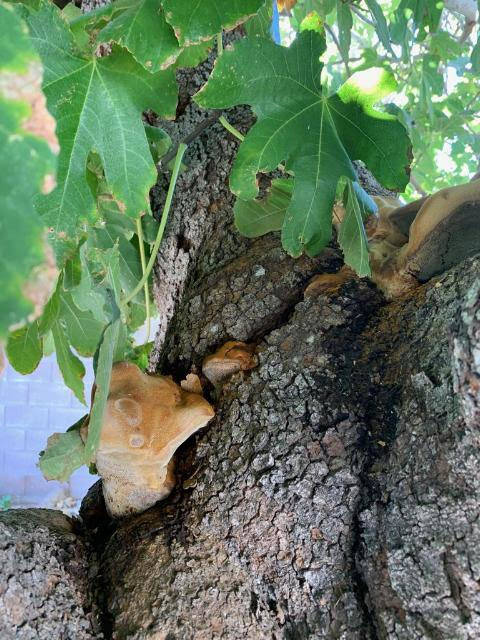Pruning wounds begin healing minutes after cut
Pruning ornamental trees and shrubs are both different and similar to pruning fruit trees and shrubs. First the similarities. Major pruning (using a saw or loppers) is done during the winter months after leaves have fallen. Minor pruning (making a single cut with a hand pruner) can be done anytime; just make sure you clean and sanitize equipment before you begin the pruning day.
The difference between the two is pruning for looks while pruning a fruit tree is more of a two-step process: pruning for structure first and then pruning for fruit production second. The main mantra when pruning fruit trees is “start from the bottom.” This allows you to evaluate the tree for its overall structure and then focus on where it produces fruit.
Pruning cuts, whether they are made with a chainsaw, a lopper or hand pruners, are no longer painted or treated in any way afterward. That idea is passé. Just like human cuts or abrasions, leave the wound in the open air for improved healing.
Healing of pruning wounds begins within minutes after the cut is made. First, a chemical barrier is established by the plant within minutes. Within about 48 hours, a physical barrier is established, and eventually, the cambium rolls over the wounded area finishing the seal.
Pruning in our desert environment is different from pruning in a tamer and more humid environment. The obvious difference is in the number of diseases available to infect plants.
Because of our dry environment, those diseases that rely on a moist environment are minimalized. We tend to see far fewer diseases in our dry environment than you might see in Illinois or Nebraska.
The second concern is damage created by the high sunlight intensity of our desert sun. For this reason, shading by future growth on fruit and young plant parts is more of a concern on the south and west sides of the tree. This goes for fruit trees as well as ornamentals.
But diseases can still be a problem here, particularly those diseases delivered to plants with dirty equipment. Ask yourself a couple of questions. Are any of my landscape plants hard-hit with diseases? Is the equipment being used on my landscape that is used somewhere else?
Be suspicious of dirty equipment brought onto your property and used on your plants, whether it’s a lawn mower, a chainsaw, loppers, hand pruners or hedge shears. If a sanitized piece of equipment cuts or injures a plant, the possibility of diseases occurring can be increased exponentially.
What to do? Insist that people performing work on your property, whether it’s with a lawn mower, a line trimmer or pruning equipment, clean and sanitize their equipment before using it on your plants. Cleaning and sanitizing equipment is a simple task and takes a few minutes more time of their time.
Don’t take no for an answer. Your plants, just like your dog or cat, rely on you.
Q: I pruned and removed a smaller side trunk, that was creating a problem, from a tree. The cut may look a little funky, but it went well overall. The cut is real wet inside and smells like manure. Is that OK? Should I let it dry out and paint it or anything?
A: As long as your equipment was cleaned and sanitized prior to making the cut, let the cut part of the tree air out. The chances of a disease being transmitted from one plant to another are slim, but that’s the nature of insurance.
Cleaning and sanitizing equipment before making a cut and opening a fresh wound in a plant are like rolling the dice. I always ask people, “Would you let your physician reuse a dirty needle on you?”
If the side limb you are removing is too large and heavy to support with your hand, then use a 1-2-3 cut. When making a 1-2-3 cut, the first cut made on a branch is an undercut about 12 inches away from the trunk and partway through it, about one third.
The second cut drops the branch from the tree and is about 6 inches from the trunk. As this larger limb begins to fall, the first cut prevents the limb from ripping the bark down the side of the tree.
Only doing the 1-2 part of the cut leaves a jagged stub attached. This is removed with a third cut that removes it with the smallest cut possible but very close to the trunk — not flush with the trunk, but nearly. Let this fresh open wound heal in the open air, just like you would a human wound.
Q: A friend has a beautiful, large fig tree. She observed large, fleshy conks growing from the trunk. Is there anything that can be done to save this old guy?
A: Fig trees can be cut very close to the ground, below the infected area where the conks are located, and one or two suckers can be allowed to grow back. If clean tools are used, new growth from the suckers will not be infected, the conks will be gone, and the tree will grow fruit.
Conks growing from the trunk of a tree are related to mushrooms. They typically indicate something is rotting on the inside of the tree where the interior wood is dead.
It’s not necessarily something that’s bad but can be used as an indicator of how serious the problem might be and how soon something should be done about it. The actual conks can be used to identify which rotting disease it is and how soon something should be done.
Eventually, the tree will have to be removed. How soon depends on the disease.
Q: I read your blog on pruning flowering shrubs, but want to know if this information also pertains to wisteria vines. I’ve read that flowering occurs on new growth, so I am not sure about trimming.
A: In my blog, Xtremehorticulture of the Desert, I tell people to differentiate between plants that flower very early in the spring versus those that flower later in the spring. Bottom line, always prune flowering trees and shrubs right after they finish flowering.
Yes, Asian wisteria vines will grow in the hot desert in a location with afternoon protection. Just make sure the soil is improved and it gets enough water.
Wisteria falls into two major groups: the Asian varieties and the Western varieties. The Asian varieties flower on last year’s growth (early spring flowers) while the American or Western varieties flower on current season growth (late spring or summer flowering).
An interesting fact about wisteria is the amount of time the plant needs to begin flowering. It’s usually quite long. Some people say 10 years to initiate flowering, others say 15, and I have even heard some people say 20 years. That’s actually quite old for a woody plant to start flowering.
A few things that affect its age when it begins flowering are removing too much larger wood, using a lot of high-nitrogen fertilizers and how much shade is present during summer months, to name a few.
Typically, unimproved woody plants begin flowering when they are about 6 to 8 years old. Plant breeding and producing hybrids that flower earlier can address this problem.
Prune it hard when it’s young and lightly thereafter. Try to leave as much older and larger wood as possible. Prune its structure the way you want it as early in its life as possible. Remember to prune after plants finish flowering and you won’t go wrong.
Fertilize flowering woody plants once a year in very early spring with a rose fertilizer and not a lawn fertilizer.
Q: I have two grapevines, and each year I cut a lot off. I would get good grapes that were very small during some years then last year only a few. This year I didn’t get one grape. Should I cut off all the dead and the trunks 5 or 6 feet up?
A: Grapes produce fruit from new growth coming from older wood. As long as the new growth grows from wood that grew from last year, it will produce grapes.
Whether to prune these vines is critical. If they produce grapes on very short growth (spur types) or whether fruit is produced further along last year’s growth (cane types) determines how and where to prune. If too much wood is removed, it can lead to no grapes produced.
The best method might be to wait until grape flowering occurs and then prune. Pruning at this time allows you to see where to prune and, if done right, balance the fruit load on the vines so grape berries can be larger. Then remember to clip the grape bunches back by one third when they come out at the end of March.
Bob Morris is a horticulture expert and professor emeritus of the University of Nevada, Las Vegas. Visit his blog at xtremehorticulture.blogspot.com. Send questions to Extremehort@aol.com.




























